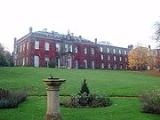
University of Nottingham Halls of Residence
Encyclopedia

Dormitory
A dormitory, often shortened to dorm, in the United States is a residence hall consisting of sleeping quarters or entire buildings primarily providing sleeping and residential quarters for large numbers of people, often boarding school, college or university students...
on the various campuses of the University of Nottingham
Campuses of the University of Nottingham
The University of Nottingham operates from four campuses in Nottinghamshire and from two overseas campuses, one in Ningbo, China and the other in Semenyih, Malaysia. The Ningbo campus was officially opened on 23 February 2005 by the then British Deputy Prime Minister, John Prescott, in the presence...
in Nottingham
Nottingham
Nottingham is a city and unitary authority in the East Midlands of England. It is located in the ceremonial county of Nottinghamshire and represents one of eight members of the English Core Cities Group...
, England
England
England is a country that is part of the United Kingdom. It shares land borders with Scotland to the north and Wales to the west; the Irish Sea is to the north west, the Celtic Sea to the south west, with the North Sea to the east and the English Channel to the south separating it from continental...
.
The University of Nottingham
University of Nottingham
The University of Nottingham is a public research university based in Nottingham, United Kingdom, with further campuses in Ningbo, China and Kuala Lumpur, Malaysia...
has a particularly well developed system of halls located on its campus. The halls acts a microcosms of the university at large and provide a community-level forum for the interaction of undergraduates, postgraduates and senior academics.
The halls are generally named either after counties, districts, or places in the English East Midlands (Nottingham having been originally conceived as a regional university for this area) or significant people associated with the university. Lenton, Lincoln, Derby, Rutland, Sherwood, Newark, Southwell, Ancaster and Melton halls fall into the former category, Hugh Stewart, Cripps, Cavendish, Nightingale, Florence Boot, Wortley, and Willoughby into the latter.
University Park Campus
All halls of residence on University Park Campus are of mixed sex undergraduateUndergraduate education
Undergraduate education is an education level taken prior to gaining a first degree . Hence, in many subjects in many educational systems, undergraduate education is post-secondary education up to the level of a bachelor's degree, such as in the United States, where a university entry level is...
type.
Ancaster
Ancaster Hall (52.9359°N 1.2077°W) provides accommodation for about 270 students and the current warden is Professor Svenja Adolphs. It was originally a women's hall, but it became one of the University's two first mixed halls along with Rutland Hall in 1970.Cavendish
Cavendish Hall (52.9361°N 1.2055°W) provides accommodation for about 279 students. The hall is named after the Cavendish family. In 2004, the Warden was Dr M M Daly. It was originally all female, but has been mixed sex since 1997. It is believed by many to be the only fully en suite hall on campus, however there are some rooms which are not en-suite.Cripps
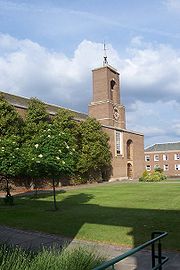
Donald McMorran
Donald Hanks McMorran RA was an English architect who is known today for his sensitive continuation of the neo-Georgian and classical tradition in the period after the Second World War...
and George Whitby, and is a grade II listed building (one of only relatively few post-war buildings to be given such status). Cripps Hall has a perennial rivalry with its neighbour, Hugh Stewart Hall. Cripps Hall is the only hall on campus to have its own gym and has won the intramural sports competition for the past three years. The current warden is Dr Gethin Roberts.
Derby
Derby Hall (52.9416°N 1.2021°W) provides Accommodation for just over 300 students. The hall is named after the local city of DerbyDerby
Derby , is a city and unitary authority in the East Midlands region of England. It lies upon the banks of the River Derwent and is located in the south of the ceremonial county of Derbyshire. In the 2001 census, the population of the city was 233,700, whilst that of the Derby Urban Area was 229,407...
. The hall, completed in 1963, was designed by the New Zealand architect, Brian O'Rourke, in classical style, around a central quad. An extension block named Matlock was later added, greatly increasing accommodation by adding 96 rooms. The current warden is Professor Charles Watkins.
Florence Boot
Florence Boot Hall (52.9343°N 1.2019°W) provides accommodation for just fewer than 200 students. The hall is named after Florence Boot, the wife of Jesse Boot, the first Lord TrentJesse Boot, 1st Baron Trent
Jesse Boot, 1st Baron Trent transformed The Boots Company, founded by his father, John Boot, into a national retailer, which branded itself as "Chemists to the Nation", before he sold out his controlling interest to American investors in 1920.John Boot offered his best friend, John Harston, the...
, a major benefactor to the University. It was opened in 1928, making it the oldest hall on the campus (Hugh Stewart Hall has existed for longer as Lenton Hall, but Florence Boot has been designated as a hall for longer). It was originally all female, but has been mixed sex since 2000. In 2008, the Warden was Gordon Airey.
Hugh Stewart

William Stretton
William Stretton was a builder and architect based in Nottingham.-Family:He was the eldest child of Samuel Stretton and was baptised at Lenton on April 20, 1755....
, as a home for Nottingham banker and owner of the Butterley Company
Butterley Company
Butterley Engineering was an engineering company based in Ripley, Derbyshire. The company was formed from the Butterley Company which began as Benjamin Outram and Company in 1790 and existed until 2009.-Origins:...
, John Wright. The hall was extended in 1937, at which time it was renamed Hugh Stewart. It was extended again in 1969. The Hall's Warden is Ms Stacy Johnson of the School of Nursing who, in September 2005 took over from archaeologist Dr Jon Henderson after he unexpectedly had to resign due to academic commitments, having being warden for only a year. He was preceded by Dr. Don Rees
Don Rees
Dr. Donald "Don" Rees was warden of Hugh Stewart Hall in the University of Nottingham for 29 years . Dr. Rees was a highly respected academic, being a professor of mathematics, and a leading member of the University community. He was the last warden to inhabit the Warden's House at Hugh Stewart in...
who had been Warden of the hall for 29 years, and after whom the hall library is named.
Lenton & Wortley
Lenton and Wortley Hall (52.9432°N 1.1986°W) is a mixed undergraduate hall of residence. It provides accommodation for just over 300 students, making it the third largest hall on campus. The hall results from the amalgamation of two previous halls of residence, New Lenton Hall and Wortley Hall, named after the local district of LentonLenton, Nottingham
Lenton is an area of the City of Nottingham in the county of Nottinghamshire, England. Politically, it falls within the Nottingham South constituency. Most of the area lies within the electoral ward of "Dunkirk and Lenton", however the "Lenton Triangle" area, considered by most residents to be part...
, and Professor Harry Almond Saville Wortley, Principal of University College Nottingham from 1935 to 1947, as well as Lenton Hurst. The Hall is home to one of the four "Mix" cafe-bars on campus. Between 1980 and 2006, the Warden was Mr William Hooker. The current warden is Professor Glenn McDowell, who was previously warden of Nightingale Hall. It includes Wortley House, a modern, three storey block consisting of 60 en-suite rooms, along with Lenton Hurst, a four storey house consisting only rooms with double beds. Situated just behind it is a bus stop which has destinations of the town centre and further out.
Lincoln
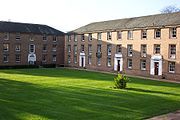
The Hall was designed by the Nottingham architect F.E. Wooley and opened in 1962; until 1997 it was an all male hall. The buildings overlook parkland at the rear and form two main courts. The rectangular lower court consists of 12 self-contained accommodation blocks, each named after places found in the county of Lincolnshire
Lincolnshire
Lincolnshire is a county in the east of England. It borders Norfolk to the south east, Cambridgeshire to the south, Rutland to the south west, Leicestershire and Nottinghamshire to the west, South Yorkshire to the north west, and the East Riding of Yorkshire to the north. It also borders...
. Accommodation is the form of single study rooms, some shared study rooms and others which have private bathrooms between two study rooms. The upper court features the dining hall, the Coveney Library, the Senior Common Room and the gatehouse, all enclosing a circular lawn. Two gilded herons, the Hall's emblem, adorn the wrought iron gates leading to the park.
Nightingale
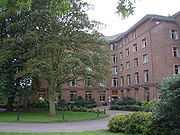
Florence Nightingale
Florence Nightingale OM, RRC was a celebrated English nurse, writer and statistician. She came to prominence for her pioneering work in nursing during the Crimean War, where she tended to wounded soldiers. She was dubbed "The Lady with the Lamp" after her habit of making rounds at night...
, and originally stored the university's collection of documents and memorabilia associated with her, although this is now stored in the Hallward Library and the Florence Nightingale Museum
Florence Nightingale Museum
The Florence Nightingale Museum is located at St Thomas' Hospital, which faces the Palace of Westminster across the River Thames in South Bank, central London, England. It is open to the public seven days a week...
in Southwark, London. Until 2000 the hall was all female, but it is now mixed. The Hall was one of the first to offer students 'large study bedroom' accommodation in September 2007 in which the rooms are fitted with three-quarter sized beds, and a mini fridge. The present warden is Professor Jan Bradley.
Rutland
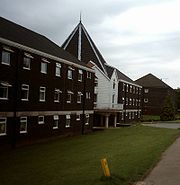
Duke of Rutland
Earl of Rutland and Duke of Rutland are titles in the peerage of England, derived from Rutland, a county in the East Midlands of England. The Earl of Rutland was elevated to the status of Duke in 1703 and the titles were merged....
himself. The hall was originally opened in 1964 as part of a large expansion of the university during that period. It was originally a men's hall but it and Ancaster became the University's first mixed halls in 1970. By the 1990s, it was clear that more accommodation was needed. Therefore, in 1993, a new, en suite wing was built — K Block. The building was completely refurbished in the summer of 1999. A particularly notable feature of the building is the unusual shape of its library, which is an octagon.
Sherwood
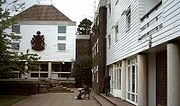
Sherwood Hall was designed as an interpretation of the traditional collegiate quadrangle, but using contemporary forms and materials. A distinctive feature is the white painted shiplap
Shiplap
Shiplap is a term used to describe a type of wooden board used commonly in the construction of barns, sheds, outbuildings and inexpensive or seasonal homes. It is either rough-sawn 1" or milled 3/4" pine or similarly inexpensive wood between 3" and 10" wide with a 3/8" - 1/2" rabbet on opposite...
weatherboarding, which gives the hall something of a North America
North America
North America is a continent wholly within the Northern Hemisphere and almost wholly within the Western Hemisphere. It is also considered a northern subcontinent of the Americas...
n feel. As originally built, the hall had a single quadrangle of accommodation blocks, with a further accommodation block and the main hall and library forming a second, but open-ended, court. Subsequent extensions have transformed this into a second quadrangle. For the first twenty-two years of its life, the warden was the late W. R. "Bunny" Chalmers. the current Warden is Dr. Antonino La Rocca.
Willoughby

Wollaton Hall
Wollaton Hall is a country house standing on a small but prominent hill in Wollaton, Nottingham, England. Wollaton Park is the area of parkland that the stately house stands in. The house itself is a natural history museum, with other museums in the out-buildings...
is just across the road from the university. 2007 saw the addition of The Mix, the largest of the 4 on campus, and subsequently the largest hall bar. The current warden is Professor Bernard McGuirk.
Jubilee Campus
As of September 2011 all of the Jubilee Campus halls fall under the authority of a single warden. At present the Jubilee Campus halls warden is Dr Slawomir Sujeki.Melton
Melton Hall is the University's only postgraduate hall of residence, and is named after the local town of Melton MowbrayMelton Mowbray
Melton Mowbray is a town in the Melton borough of Leicestershire, England. It is to the northeast of Leicester, and southeast of Nottingham...
. It provides accommodation for 149 students, and along with the rest of the first stage of the campus, was designed by Sir Michael Hopkins. The hall is self-catered, with each kitchen shared by up to thirteen students. Administration is provided by Southwell Hall. All rooms are en-suite. Melton Hall has two common rooms and one study room.
Newark

Newark-on-Trent
Newark-on-Trent is a market town in Nottinghamshire in the East Midlands region of England. It stands on the River Trent, the A1 , and the East Coast Main Line railway. The origins of the town are possibly Roman as it lies on an important Roman road, the Fosse Way...
, sharing its coat of arms and motto "Deo Fretus Erumpe" ("Trust in God and Sally Forth"). Housing about 400 students, this makes it the second largest hall of residence in the University (after Bonington Hall). As the rest of the campus, it was designed by Sir Michael Hopkins in the shape of an eight framing two quads surrounded by the building.
Southwell
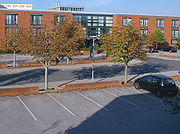
Southwell, Nottinghamshire
Southwell is a town in Nottinghamshire, England, best known as the site of Southwell Minster, the seat of the Church of England diocese that covers Nottinghamshire...
. It houses about 200 students, and along with the rest of the first stage of the campus, was designed by Sir Michael Hopkins. The administrative team also cover Melton Hall.
Sutton Bonington Campus

- Kingston - the oldest hall, built just before the First World War and used to house German POWs during the war; until recently it was an all-male hall
- Normanton - originally built as an all-female hall, and remained so until recently
- Wymeswold
- Ratcliffe
- Rempstone
- Kegworth
- Dishley
- Hathern
- Lockington
- Zouch
- Stanford
- Barton
- Costock
- Thrumpton
- Eviton House - postgraduate-only house at the far end of the arboretum
- St. Michaels Flats - located nearer the village itself, these house students with families, mainly international students
University-arranged self-catering accommodation
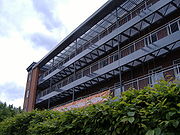
- Broadgate ParkBroadgate ParkBroadgate Park is a self-catered hall of residence at the University of Nottingham for undergraduate and postgraduate students. Housing about 2400 students and containing 2,223 rooms it is one the largest student villages in Europe. It is located outside of the West Entrance of the University Park...
is a collection of self catered student accommodation, forming Europe's largest 'student village' of some 2400 undergraduate and postgraduate students (although this is dependant on "Cite Universitaire de Paris" being excluded on the grounds that it is largely for international students). It is operated privately by UPP (Broadgate Park) Ltd and is situated immediately to the southwest of University Park, between the campus and the town of BeestonBeeston, NottinghamshireBeeston is a town in Nottinghamshire, England. It is southwest of Nottingham city centre. Although typically regarded as a suburb of the City of Nottingham, and officially designated as part of the Nottingham Urban Area, for local government purposes it is in the borough of Broxtowe, lying outside...
. The current Warden is Dr Steve Greedy of the Department of Electrical & Electronic Engineering.
- Raleigh Park is a self-catering hall located close to Jubilee Campus, though not very close to the university campus. It is owned and operated by Derwent Living. It consists of five courts: Sillitoe, Madison, Roddice, Byron and Chatterley.
- St. Peter's Court is a self catering hall, owned and managed by Unite, who run numerous other third party halls across the country. Recently extended it can now house over 800 students all with en suite rooms.
- Cloister House is a self catering hall, owned and managed by UPP (Broadgate Park) Ltd, housing almost 70 postgraduate students outside the south east corner of University Park in the DunkirkDunkirk, NottinghamDunkirk is a residential area of Nottingham, England which is located to the south east of the University of Nottingham and the Queen's Medical Centre...
area.
- Albion House is a self catering hall, owned and managed by UPP (Broadgate Park) Ltd, housing mainly undergraduate students and situated in the town of Beeston.
Defunct Halls
University Hall was a hall-grouping to which all off-campus students belonged in the days before such a group became so large that it was meaningless to attempt to make it conform with the halls system. The hall was dissolved in the 1990s.Wortley Hall was a hall named after the last Principal of University College Nottingham, Harry Wortley. It was located in the extreme north of University Park in Lenton Firs House. The hall was subsumed by New Lenton Hall in the 1980s, with the School of Architecture (now the School of the Built Environment) taking over the occupation of Lenton Firs.

